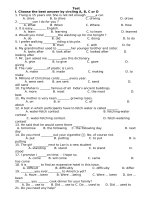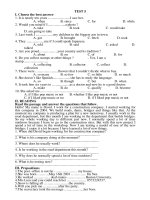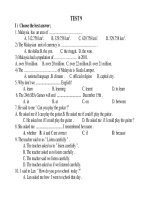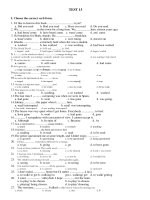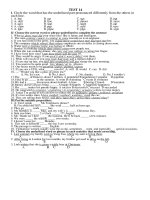Marketing management topic 8 introducing new market offering
Bạn đang xem bản rút gọn của tài liệu. Xem và tải ngay bản đầy đủ của tài liệu tại đây (189.11 KB, 21 trang )
MARKETING MANAGEMENT
Topic 8
Introducing New
Market Offerings
Kotler
Keller
Chapter Questions
What challenges does a company face in
developing new products?
What organizational structures are used to
manage new-product development?
What are the main stages in developing new
products?
What is the best way to set up the new-product
development process?
What factors affect the rate of diffusion and
consumer adoption of newly launched products?
20-2
Categories of New Products
New-to-the-world
New product lines
Additions to product lines
Improvements to products
Repositionings
Cost reductions
20-3
Factors That Limit New Product
Development
Shortage of ideas
Fragmented markets
Social and governmental constraints
Cost of development
Capital shortages
Faster required development time
Shorter product life cycles
20-4
Venture Team
Cross-functional group charged with
developing a specific product or business;
Intrapreneurs are relieved of other duties
and provided a budget and time frame.
20-5
Criteria for Staffing Venture Teams
Desired team leadership style
Desired level of leader expertise
Team member skills and expertise
Level of interest in concept
Potential for personal reward
Diversity of team members
20-6
Idea Generation: Creativity Techniques
Attribute listing
Forced relationships
Morphological analysis
Reverse assumption analysis
New contexts
Mind mapping
20-7
Variations on Failure
Absolute product failure
Partial product failure
Relative product failure
20-8
Concepts in Concept Development
Product idea
Product concept
Category concept
Brand concept
Concept testing
20-9
Concept Testing
Communicability and believability
Need level
Gap level
Perceived value
Purchase intention
User targets, purchase occasions,
purchasing frequency
20-10
Marketing Strategy
Target market’s size, structure, and
behavior
Planned price, distribution, and promotion
for Year 1
Long-run sales and profit goals and
marketing-mix strategy over time
20-11
Product Development
Quality function deployment
(QFD)
Customer attributes
Engineering attributes
20-12
Prototype Testing
Alpha testing
Best testing
Rank-order
method
Paired-comparison method
Monadic-rating method
Market testing
20-13
Consumer Goods Market Testing
Sales-Wave Research
Simulated Test Marketing
Controlled Test Marketing
Test Markets
20-14
Test Market Decisions
How many test cities?
Which cities?
Length of test?
What information?
What action to take?
20-15
Timing of Market Entry
First entry
Parallel entry
Late entry
20-16
Criteria for Choosing Rollout Markets
Market potential
Company’s local reputation
Cost of filling pipeline
Cost of communication media
20-17
Consumer-Adoption Process
Adoption is an individual’s decision
to become a regular user
of a product.
20-18
Stages in the Adoption Process
Awareness
Interest
Evaluation
Trial
Adoption
20-19
Adopter Categorization
Innovators
Early adopters
Early majority
Late majority
Laggards
20-20
Characteristics of an Innovation
Relative
advantage
Compatibility
Complexity
Divisibility
Communicability
20-21

